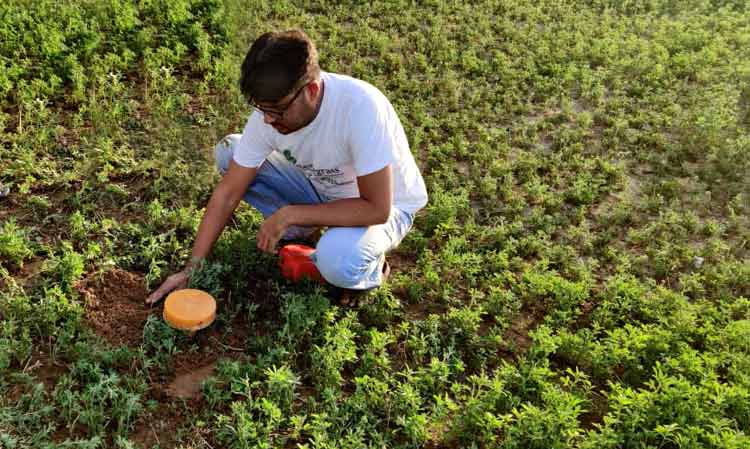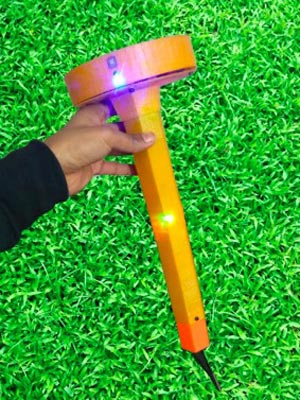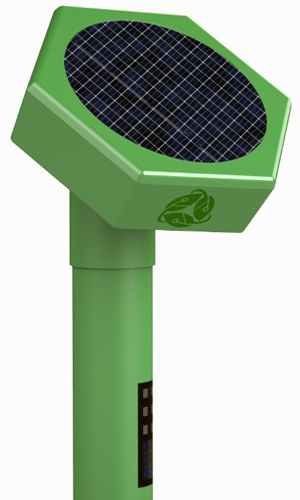
Today one of the largest problems that pose an imminent threat to humanity is Food Scarcity. The standard agricultural practices as we know them cannot cope up with the current unpredictable climate change and rainfall scarcity, a feasible solution to this problem could be Precision Farming. The idea behind precision farming is to improve farming efficiency by adopting modern technologies to collect vital data points from the field and analyze them to curate, predict and prescribe the best farming practice. One such company, which is working towards Precision farming solution is Sensegrass.
Curious to know more about Sensegrass and its products, we approached Mr. Rahul Gundala, who is the co-founder and CTO of Sensegrass. Read on to know all details he shared about the company, their present, and upcoming projects.
Q. What is the idea behind sensegrass? What kind of solutions and services do you offer?
It all started when me and my friend, Lalit was part of a social impact initiative for climate change at the World Economic Forum. Looking at large-scale data, and coming from a farming background, we realized that simple solutions using AI technology can solve large-scale problems in the farming industry. We understood the practical challenges farmers face on the ground and built our solutions as co-creation with lots of research with customers. With Lalit’s background in plant sciences and mine in technology, we realized the potential of how we could solve a few of the high-impact problems by improving farming techniques.
Today, as part of our product line, we offer a soil intelligence platform for farmers that helps understand crop conditions, soil health, environmental changes and we also give actionable insights on precision farming to improve crop yield and reduce chemicals usage. We also give actionable insights to farmers on how they can improve their profit, while using fewer amount of resources, like fertilizers, pesticides. We do this using a lot of data points across various channels. We give them precision agriculture information like you have to focus on one specific area for those fertilizers and then while reducing the fertilizer usage; we also improve the yield output.
We understand that every crop requires precise attention and we deliver those actionable insights to farmers. This is done with the help of our SaaS application, which is a web and mobile application. Apart from that, we have our patented IoT soil sensor probes that give 14 different soil parameters including NPK at 3 different depth levels in real-time.

Q. What type of farmers or farmland owners can be benefited from Sensegrass? Can you give an example with a case study?
During the early days of our journey, we focused on small and mid-size farmers but realized that ROI on Capex is not feasible. Later, we started working on innovating business model to make our solutions almost free for farmers. We primarily sell our solution to large farm corporates, FMCG brands, retail chains, and plant science companies where they have contract farmers from whom they procure produce or have a need to monitor the data to improve their product. Our end-user is a farmer and the customer is agro-corporates where both have a win-win model where agro companies can make their products and services more efficient using the data that we generate through the platform, and the farmer can use the product to increase their crop yield.
Q. What are the different types of data that are collected from an Agriculture Farm and how does Sensegrass collect them periodically?
We source our data from four channels viz. soil parameter from our IoT soil probe, GIS satellite image data (public & private), environmental data (weather and climate), historic soil health card data + farm activity logs. In each of these channels, we have set frequency intervals depending on the crop type.

Soil Probe is our primary channel which collects 14 different soil parameters across various depth levels, which is including the NPK sensor; it's a patented soil sensor with an instance. We use optical spectroscopy, which has an edge over the rest of the competition. Apart from that, we also source information from public and private satellite sources, satellite images, and then we process using GIS engines. We do web scraping from public and publicly available soil health information to us historic soil and one of the most important being environmental information data source. On average, we do around 1000 data points per crop.
We primarily collect NPK (nitrogen, phosphorus, sodium), and we also collect soil temperature, soil moisture, then the lux value from the chlorophyll point of view. We have various other parameters like pH values and oil components and nutritional values as well.
Q. How many probes does your company plans to deploy and at what intervals? Are they wireless and what’s their battery life?
Our whole probe or the product itself is modular and depending on the customer requirements, we can quickly modify or interchange based on the network technology available at that particular location. Only the network unit can be swapped with the rest of the probe. As of now, we offer LoRa and we have a 5G-enabled version as well, which is backward compatible up to 2G. We are primarily working in Europe and the US.
Coming to the number of sensors deployed per field, it depends on the land itself. If it's even landform, then one sensor supports up to 10 acres, we can average out the values up to 10 acres. It also depends on what crop you're growing. If it's a high cash crop, we recommend more sensors within a small plot area. We have enabled this with a solar-powered system but in case there is no sunlight, it can last up to two days.

Q. How does Sensegrass leverage AI and ML to increase crop yield and farming efficiency?
Sensegrass, at its core, is an AI and Data Science company. We compute thousands of data points from various channels to address various micro-services we offer. As a simple use-case of one of our micro-service, Plant card is an AI model that gives the ideal soil condition for maximum yield output. For example, if it's corn, what needs to be the nitrogen value of that particular geography of the plant, and what needs to be the value of nitrogen at that particular geography.
This has been computed with lots of other conditions like it considers soil replenishment; it considers environmental changes, macro trends, and real-time soil condition. It gives insights to farmers on what needs to be maintained to get maximum yield output while also taking care of the long-term vision of the plot area.
Wherein a conventional agronomist gives suggestions and actionable insights to farmers, what we do is a step ahead. The AI model that we created recognizes various patterns that are going into the crop sector. For example, with a similar environmental condition that is expected in the next week, we can understand what kind of impact it would have on the next crop cycle. This kind of observation and pattern recognition is only possible through the machine. Manually, it's tough to have that huge macro view of the entire data. That's the kind of AI power that we use at Sensegrass.
Q. What kind of technical difficulties do you normally face when deploying sensors in farmland? How does sensegrass deal with it?
We were the first company in the market that used optical spectroscopy to develop this technology. When we incepted, we were a pure hardware company. Our entry was through our hardware product, Soil Probe. Later on, we pivoted to being SaaS first platform. When we started, we faced problems like understanding how to cut down the cost to make it more effective to midsize farmers and how to ensure that these are the standard protocols that we need to follow. We also faced a lot of other production-level challenges where the prototype was quickly made because we already come from a technology background but when we made the transition to make it a production-level product, there are a lot of things that we learned on the way.
Q. How do you see the supply chain in India to make all these probes? Where do you source your components from?
Our primary source has been Taiwan and China but right now, we are planning to get this all done in-house. We do it on a request basis, we have a very limited stock as of date, but we also have supply chain partners who we are working with.
Q. How do you see drones and rovers for collecting data from farmland? Would they be a viable replacement for probes and other sensors deployed in the field?
I would bet my money more on the rover part because drones are a capital-intensive thing and generations of evolution will bring that down. But rover becomes interesting, in one of our product roadmaps, we're creating a modular drone, which can be used for multiple purposes, right from doing farm activities like spraying, fertilizing, or even pest detection, etc. These kinds of activities can be moved around and one very strong motivation for us to work on the rover is that the same soil probe can be used across the field. We have pit stops across the plot area, and the rover will collect these data at various pit stops, and then we get back the information.
Q. Sensegrass is working on a prototype for the rover now, how much have you progressed with this idea?
The basic framework is ready and we are working on making it all-terrain. That's been the kind of side project for us; our primary focus has been on making our AI model more efficient and getting more data. But that's something that we could get out in the market in the next year.
Q. Tell us about your plans and pricing, why did Sensegrass choose a subscription-based model?
We started empathizing with the customer as we come personally from a farming background, so we understood that this is a capital-intensive business for farmers. They don't see our ROI from such capital intensive point of view. That’s when we came with bundled packages, where the capex cost of the sensors is what we divide across the subscription. That's how it becomes more affordable.
It's a win-win situation on both ends for the company as well because later after a year, we start getting returns and that's a recurring return, even the investors and the whole ecosystem is happy about that. That's the kind of innovation that we have done, but we are at a very early stage to fine-tune our bundle packages, we just got started with that kind of model. As of date, we have been primarily a licensed-based large-scale company, we deal with agro corporates; we have been doing our annual licenses and large-scale deals with companies.
Q. How do you see the market for Smart Farming Technology? What are your plans for Sensegrass?
That’s one important thing that the rest of the trend will follow, it’s the next big wave! The obvious challenge is to cater to the food needs of a huge population that is constantly growing. Becoming optimized or efficient in farming is the next obvious challenge that a lot of technology companies need to address. We are planning to create an operating system for farmers, so that's our vision for the next two to three years. We would want to be the core platform on top of which various additional extensions or modules can work. We would be the data net or the grid of data, and a lot of other players can work on top of this data to give services.

